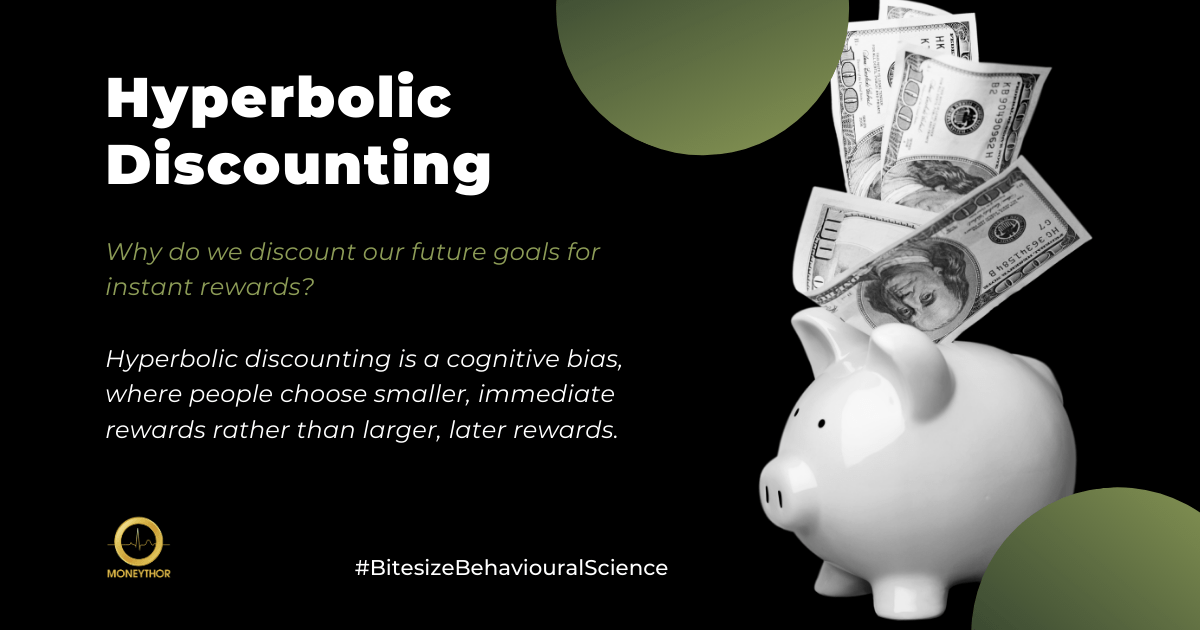We have all been there, our plans to eat healthily or save for the future are forgotten the instant we see a piece of cake or new phone we want to buy. Why do we discount our future goals for instant rewards? To explain why we do this, behavioural scientists have coined the phrase hyperbolic discounting.
What is hyperbolic discounting?
“Hyperbolic discounting is a cognitive bias, where people choose smaller, immediate rewards rather than larger later rewards and this occurs more when the delay is closer to the present than the future.”
Hyperbolic discounting is usually studied by asking people if they would rather get $50 now or $100 next year. Results show that people are more likely to choose the lesser reward now rather than wait for the higher reward in the future. However, when people are offered $50 next year or $100 in 5 years, people are more likely to choose the latter. This is because waiting a year does not create the instant reward or gratification that we look for.
How does hyperbolic discounting effect people?
Hyperbolic discounting can cause poor-decision making as it promotes immediate gratification and encourages impulsive decisions. At the same time, it makes the long-term benefits of decisions less clear and less valuable, therefore pushing us to select the instant smaller reward.
Why does hyperbolic discounting happen?
There are a few reasons why people choose a small instant reward over a larger future reward and these include:
- People are risk averse
People prefer a sure thing and there can be a perceived risk attached to long-term rewards because of their uncertainty compared to immediate ones.
- People are aware that their preferences might change
A lot can change over time, so people are keen to satisfy their current wants because they may not care for $100 in the future.
- People have an urgent need
In some situations, people need the reward now and do not have the luxury of waiting a year to receive it, this is particularly true for those in lower-income households. This is a key factor as to why lower-income people are less likely to save or invest their money.
How can banks and financial service providers help their customers to avoid hyperbolic discounting?
- Consider the immediacy of the benefits of the product or service you are offering
If you are encouraging your customers to sign up for a financial product or service, consider how you can create immediate benefits for signing up. For example, offer a reward for signing-up or purchasing a product (e.g. signing up for a credit card, give extra points at sign-up).
- Pre-commitment
One way to prevent hyperbolic discounting is by implementing another behavioural science device, pre-commitment. Pre-committing to a goal is frequently used to achieve positive change. Committing to a specific future action (e.g. saving for a mortgage) at a particular time (e.g. once a month when salary is paid) tends to motivate action while also reducing distraction.
- Break down goals into manageable chunks
Give customers the tools to break down their goals into chunks or parts. With the Moneythor solution, our clients can set up savings goals with specific milestones throughout the savings journey. For example, customers can receive notifications when they have reached a certain percentage of their goal (e.g. 20%, 50%, etc.) which keeps them on track and stops them from discounting their future goals.
Understanding how hyperbolic discounting can prevent customers from making smart financial decisions for their future and implementing devices and recommendations that counteract hyperbolic discounting can lead to improved financial well-being for customers and increased success for marketing campaigns.

